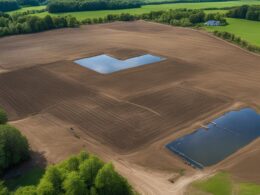Are you looking to transform your lawn into a vibrant and luxurious oasis? Look no further than bermuda grass. With its lush texture and exceptional resilience, bermuda grass is the perfect choice for creating a picturesque outdoor space.
This warm-season grass, originating from Africa and the bengal region of India, has found its way to the southern half of the United States. Its ability to thrive in high foot traffic areas and withstand harsh conditions, such as scorching heat and drought, make it a top pick for homeowners and landscapers alike.
Whether you’re a homeowner or a professional landscaper, understanding the details of bermuda grass is crucial for achieving a lush and vibrant lawn. In this article, we will explore the features that make bermuda grass a popular choice, giving you the knowledge to create a stunning outdoor space.
Factors to Consider When Choosing Lawn Grass
When it comes to selecting the perfect grass for your lawn, several factors should influence your decision. Taking into account factors such as region, climate, intended use, and desired appearance can significantly impact the success and overall satisfaction you’ll experience with your lawn.
Different grass varieties thrive in different conditions, so it’s crucial to choose a variety that is well-adapted to your specific location. Considering your region’s climate and the amount of sunlight, rainfall, and temperature it receives will help you narrow down the options and make an informed choice.
Take into account the intended use of your lawn as well. Will it primarily serve as a play area for children and pets, or do you envision a more formal, aesthetically pleasing landscape? Certain grass types are better suited for heavy foot traffic, while others may be more visually appealing, so it’s essential to align your choice with your specific needs and preferences.
Finally, your desired appearance plays a significant role in selecting lawn grass. Determine whether you prefer a lush, dark green lawn or a more natural-looking, drought-tolerant grass. Some grass varieties require more maintenance and watering to achieve the desired look, so factor in the level of effort you’re willing to invest in lawn care.
In North Carolina, for instance, the climate varies across different regions, making it important to choose between cool-season and warm-season grasses accordingly. By considering these factors and doing thorough research, you can make an informed decision and choose the right grass variety that will thrive in your specific environment.
Cool-Season Grasses for North Carolina Lawns
In North Carolina, if you’re looking to maintain a vibrant lawn throughout the winter months, cool-season grasses are your best option. These varieties, including tall fescue, Kentucky bluegrass, fine fescue, and perennial ryegrass, are commonly used for lawns in the state.
Unlike warm-season grasses, cool-season grasses remain green during the colder months and perform at their best in the spring and fall. They are well-suited to the climate and conditions of the North Carolina mountains and piedmont regions.
To achieve optimal results with cool-season grasses, it is recommended to seed them in early fall. This time of year provides the ideal conditions for germination and root establishment, allowing the grass to thrive during the cooler months.
Benefits of Cool-Season Grasses
- Winter Resilience: Cool-season grasses maintain their green color during winter, providing visual appeal to your lawn even in chilly months.
- Spring and Fall Performance: These grasses thrive in the moderate temperatures of spring and fall, ensuring a lush and healthy lawn.
- Adaptability to North Carolina Regions: Cool-season grasses are well-adapted to the specific conditions of the mountains and piedmont regions in North Carolina, making them a suitable choice for homeowners in these areas.
By selecting cool-season grasses for your North Carolina lawn, you can enjoy a beautiful and vibrant outdoor space year-round, even during the cooler seasons.
Warm-Season Grasses for North Carolina Lawns
When it comes to maintaining a vibrant and lush lawn in North Carolina, choosing the right warm-season grass is essential. Warm-season grasses are well-suited to the climate and conditions of the piedmont and coastal plain regions, thriving in the summer months and going dormant in the fall. Planting warm-season grasses like bermudagrass, zoysiagrass, centipedegrass, St. Augustinegrass, carpetgrass, and bahiagrass is highly recommended to ensure a beautiful and low-maintenance lawn.
Unlike cool-season grasses, which are often blended or mixed together, warm-season grasses are generally planted as single varieties. This allows for precise management of the lawn’s appearance and characteristics. Late spring or early summer is the ideal time to plant warm-season grasses, giving them ample time to establish strong root systems before the hot summer months.
With their ability to withstand the heat and unique adaptability to North Carolina’s coastal and piedmont regions, warm-season grasses are the perfect choice for homeowners looking to achieve a vibrant and resilient lawn. Using proper care and maintenance techniques, you can enjoy a beautiful lawn throughout the summer months, offering a picturesque setting for outdoor activities and relaxation.
By selecting warm-season grasses that are well-suited to North Carolina’s climate and conditions, you can create the perfect foundation for a stunning and low-maintenance lawn. Whether you choose bermudagrass, zoysiagrass, centipedegrass, St. Augustinegrass, carpetgrass, or bahiagrass, your lawn will flourish and enhance the aesthetic appeal of your property.
Can Close-up Details of Bermuda Grass Help Identify and Prevent Fungus Growth?
Close-up details of Bermuda grass can indeed help identify and prevent fungus growth. By closely inspecting the grass, one can look for signs of discoloration, spots, or unusual growth patterns, which may indicate the presence of fungus. Implementing Bermuda grass fungus prevention solutions can help maintain the health and appearance of the lawn.
Conclusion
Choosing the right grass for your lawn is crucial for achieving a lush and resilient lawn. When making your selection, consider factors such as the region, climate, intended use, and desired appearance. By understanding the specific needs of your lawn, you can ensure the grass variety you choose is well-adapted to your location.
In North Carolina, there are suitable grass options for different regions. Cool-season grasses like tall fescue, Kentucky bluegrass, fine fescue, and perennial ryegrass thrive in the mountains and piedmont areas. These grasses remain green throughout most of the winter and perform well in the spring and fall. On the other hand, warm-season grasses like bermudagrass, zoysiagrass, centipedegrass, St. Augustinegrass, carpetgrass, and bahiagrass are recommended for the piedmont and coastal plain regions. These grasses flourish during the summer and go dormant in the fall.
Proper care and maintenance are essential for a beautiful and healthy lawn. Regular watering, mowing, and fertilizing can help maintain the vitality and appearance of your grass. Additionally, addressing any pest or weed issues promptly can prevent them from damaging your lawn. With the right grass selection and proper upkeep, you can enjoy a stunning lawn that enhances the beauty of your home.










